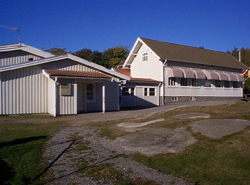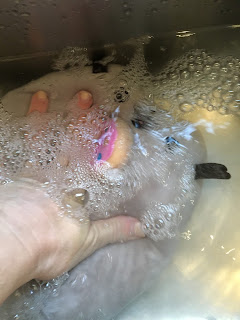Today, the girls and I visited our neighborhood school.
 |
| Photo from stromstadstidning.se |
School here begins at 7:45am, earlier than is typical for Swedish schools, because it's based on the local bus schedule. Kids arrive and leave their shoes and coats in a large entryway. Everyone wore socks inside, except the teachers who wore sensible, indoor shoes (not winter boots).
The school here only has three classrooms, since it serves a very small community. One class is a preschool, with at least 3 teachers. The kids in the preschool class range in age from toddler (youngest was just 1.5 years old) to 6 years old. Preschool is free for kids starting at age 3, for up to 15 hours per week. For full day preschool, families pay about 1000 kronor a month (about $100).
 |
| Part of the preschool room. |
At age 6, Swedish kids begin a regular class, which is similar to our Kindergarten. The teachers at Tjärnö Skola said that it's common in Sweden for kids in this class to move back and forth between the 1-5 year old class and the 6-year-old class, when they need more play.
 |
| More of the preschool space. |
 |
| Another view of the preschool space. |
Kids are not required to attend school in Sweden until age 7. Their 1st grade is for 7-year-olds (who would be starting 2nd grade in the US). The girls were a bit distressed to know that in Sweden, they'd only be in 2nd and 4th grade.
 |
| The younger kids' classroom (ages 7-9). |
Because Tjärnö Skola is so small, the 6-year-olds stay in the Preschool with the 1-5 year olds. There were only a handful of kids in the preschool. The next class was for 7, 8, and 9 year olds and had about 10 students. And the final class had 10, 11, and 12 year olds and also had about 10 kids.
 |
| Teacher's desk |
The oldest kids here are in 6th grade; they'd be 7th graders in the States. Next year, these kids will attend the local middle school, where they'll stay for for three years. Finally, they go to a three-year high school program, serving ages 16-19.
 |
| Older kids at their desks. |
 |
| Chelsea and Savannah with one of the teachers |
The older kids' weekly schedule interested me the most. Hour-long blocks of instruction, followed by at least 15 minutes of break. The subjects included Swedish, English (2 hours per week), Math, Science (which includes tech), and Social Studies (which includes geography and religion), and PE (Sports and Health, 2 hours per week).
 |
Weekly schedule for the older class.
NO = Science, SO = Social Studies |
At break time, the kids 7 and up all went outside to play. The preschool kept a different schedule. The playground isn't big and has very little to play on: some blacktop with a couple of hopscotch patterns, one basketball hoop, some rocks that the kids climbed on. The kids from both the classes all played games together. They tried to teach my girls a Swedish version of hide and seek, but we couldn't quite understand how it worked. The teachers take turns supervising them.
 |
| Outside view of the school. |
The older kids also go into town to the middle school one morning each week for music, crafts, and cooking class. They take the bus into town on their own and come back to school around midday. All of the students swim at the
local pool at least once a week.
 |
| At the back of the younger kids' room. |
Our visit caused a bit of disruption. The kids were excited, and the classes were off their usual routines. It was interesting that even in a foreign country it was easy for me to spot which kids kept the teacher on her toes, which ones were the quiet types, and which were the teacher's pets.
 |
| Giant relief map of Europe. |
After we toured the school and talked with the younger class, we did a conversation activity with both classes together. As usual here, almost everyone's English vastly outpaced our limited Swedish. The oldest kids had the best command of English grammar and vocabulary. There were two sisters who are recent immigrants from Eritrea, so they were still working on learning Swedish.
 |
| Discussion topics on the board. |
The school has a tiny and adorable cafeteria. At snack time, the lunch lady put out a bowl of sliced melon, which the kids helped themselves to as they went out to play. At 11:15, all the kids 7 and above and their teachers went to the little cafeteria for lunch. Today's lunch was a root vegetable soup, served with bread, butter, cheese, yogurt, and some Swedish salads. After lunch, they had a break again until noon.
 |
| Savannah's first school cafeteria lunch! |
We left at midday and took the bus into town. A teacher asked me to make sure that one of the 7-year-olds made it onto the bus. All of the kids get out at noon on Friday, and the youngest kids leave school at noon several days a week. We waited outside with him and sat with him on the bus. It was about 15 minutes to his stop. He spoke very little English. We had him teach us some basic Swedish: numbers 1-10, items of clothing, some body parts. We all cracked up at his attempts to teach us the
Swedish word for "seven" and our failed attempts to pronounce it properly.
This is the school that the girls would attend, if they were going to school here. After visiting, I have mixed feelings about choosing not to send them. Since it's so small, it would probably be a very easy transition for them and they'd get lots of attention. It would be nice for them to be with other kids, go swimming, take music and cooking class, play outside, and do all the things that school kids do. The teachers invited us to come back, so perhaps we can have a bit of both worlds.


















































